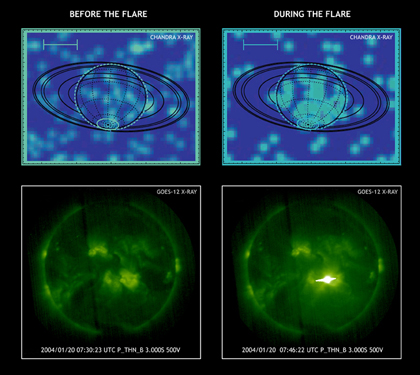NASA's Chandra Finds That Saturn Reflects X-rays From Sun
Chandra observations of Saturn (upper panel) show that Saturns atmosphere acts like a mirror that reflects explosive activity on the Sun (lower panel).
On January 20, 2004 a large flare erupted on the Sun. The flare lasted for 36 minutes and was detected by radio and optical telescopes, as well as an X-ray telescope (lower panels) aboard GOES-12, one of the National Oceanic and Atmospheric Administrations Geostationary Operational Environmental Satellites.
About two hours and 14 minutes later, Saturn was observed by Chandra to brighten in X-rays. This time delay corresponds to the difference in time it takes for X-rays, or any other form of light, to make the trip from the Sun to Saturn and back to Earth as opposed to traveling directly from the Sun to the Earth.
This observation demonstrates that the upper atmospheres of the giant planets Saturn and Jupiter act as diffuse mirrors that reflect solar X-rays. Although their atmospheres reflect less than a tenth of a percent of the incident X-rays, Saturn or Jupiter might be used as potential remote-sensing tools to monitor X-ray flaring on portions of the hemisphere of the Sun facing away from near-Earth space weather satellites.
|
||||||||||||||||||||||||||
Two Chandra observations of Saturn (upper panel) show that Saturn's atmosphere acts like a mirror that reflects explosive activity on the Sun (two images shown in the lower panel). The Sun images look like dark green globes with the right one having a bright white splotch of white across a part of its midsection. The Chandra images show splotchy blue-green texture with lines overlaying the typical Saturn planet shape. On January 20, 2004, a large flare erupted on the Sun. The flare lasted for 36 minutes and was detected by radio and optical telescopes, as well as an X-ray telescope (lower panels) aboard GOES-12, one of the National Oceanic and Atmospheric Administration's Geostationary Operational Environmental Satellites. About two hours and 14 minutes later, Saturn was observed by Chandra to brighten in X-rays. This time delay corresponds to the difference in time it takes for X-rays, or any other form of light, to make the trip from the Sun to Saturn and back to Earth as opposed to traveling directly from the Sun to the Earth.






